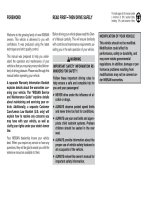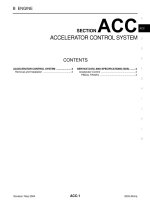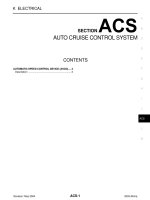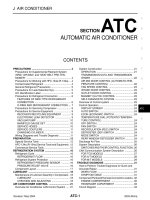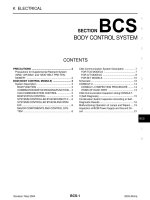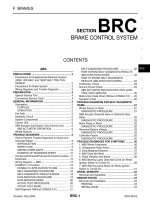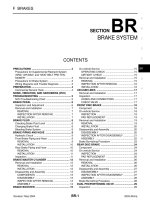BR hệ THỐNG THẮNG NISSAN ALTIMA 2003
Bạn đang xem bản rút gọn của tài liệu. Xem và tải ngay bản đầy đủ của tài liệu tại đây (817.08 KB, 30 trang )
F BRAKES
A
B
SECTION
BRAKE SYSTEM
C
D
E
CONTENTS
PRECAUTIONS ......................................................... 3
.
Precautions for Supplemental Restraint System
(SRS) “AIR BAG” and “SEAT BELT PRE-TENSIONER” ................................................................. 3
.
Precautions for Brake System ................................. 3
.
Wiring Diagrams and Trouble Diagnosis ................. 3
.
PREPARATION .......................................................... 4
.
Commercial Service Tools ....................................... 4
.
NOISE, VIBRATION, AND HARSHNESS (NVH)
TROUBLESHOOTING ............................................... 5
.
NVH Troubleshooting Chart .................................... 5
.
BRAKE PEDAL ......................................................... 6
.
Inspection and Adjustment ...................................... 6
.
Removal and Installation ......................................... 7
.
REMOVAL ............................................................ 7
.
INSPECTION AFTER REMOVAL ........................ 7
.
INSTALLATION .................................................... 7
.
BRAKE FLUID ........................................................... 8
.
Checking Brake Fluid Level .................................... 8
.
Changing Brake Fluid .............................................. 8
.
Bleeding Brake System ........................................... 8
.
BRAKE PIPING AND HOSE ..................................... 9
.
Hydraulic Circuit ...................................................... 9
.
Front Brake Piping and Hose .................................. 9
.
REMOVAL ............................................................ 9
.
INSTALLATION .................................................. 10
.
Rear Brake Piping and Hose ................................. 10
.
REMOVAL .......................................................... 10
.
INSTALLATION ...................................................11
.
Inspection ...............................................................11
.
BRAKE MASTER CYLINDER ................................. 12
.
Removal and Installation ....................................... 12
.
REMOVAL .......................................................... 12
.
INSTALLATION .................................................. 12
.
Disassembly and Assembly .................................. 13
.
COMPONENTS ................................................. 13
.
DISASSEMBLY .................................................. 13
.
INSPECTION AFTER REMOVAL ...................... 14
.
ASSEMBLY ........................................................ 14
.
BRAKE BOOSTER .................................................. 15
.
Revision: May 2004
On-vehicle Service ................................................ 15
.
OPERATING CHECK ......................................... 15
.
AIRTIGHT CHECK ............................................. 15
.
Removal and Installation ....................................... 15
.
REMOVAL .......................................................... 15
.
INSPECTION AFTER REMOVAL ...................... 16
.
INSTALLATION .................................................. 16
.
VACUUM LINES ...................................................... 17
.
Removal and Installation ....................................... 17
.
Inspection .............................................................. 17
.
HOSES AND CONNECTORS ............................ 17
.
CHECK VALVE ................................................... 17
.
FRONT DISC BRAKE .............................................. 18
.
Component ............................................................ 18
.
On-vehicle Service ................................................ 18
.
INSPECTION ..................................................... 18
.
PAD REPLACEMENT ........................................ 19
.
Removal and Installation ....................................... 19
.
REMOVAL .......................................................... 19
.
INSTALLATION .................................................. 20
.
Disassembly and Assembly ................................... 20
.
DISASSEMBLY .................................................. 20
.
INSPECTION AFTER DISASSEMBLY ............... 21
.
ASSEMBLY ........................................................ 22
.
Brake Burnishing Procedure .................................. 23
.
REAR DISC BRAKE ................................................ 24
.
Component ............................................................ 24
.
On-vehicle Service ................................................ 24
.
INSPECTION ..................................................... 24
.
PAD REPLACEMENT ........................................ 25
.
Removal and Installation ....................................... 26
.
REMOVAL .......................................................... 26
.
INSTALLATION .................................................. 26
.
Disassembly and Assembly ................................... 27
.
DISASSEMBLY .................................................. 27
.
INSPECTION AFTER DISASSEMBLY ............... 27
.
ASSEMBLY ........................................................ 28
.
Brake Burnishing Procedure .................................. 28
.
DUAL PROPORTIONING VALVE ............................ 29
.
Inspection .............................................................. 29
.
BR-1
2003 Altima
BR
G
H
I
J
K
L
M
SERVICE DATA AND SPECIFICATIONS (SDS) ..... 30
.
General Specifications ........................................... 30
.
Disc Brake ............................................................. 30
.
Revision: May 2004
Brake Pedal ...........................................................30
.
Control Valve ..........................................................30
.
Brake Booster ........................................................30
.
BR-2
2003 Altima
PRECAUTIONS
PRECAUTIONS
PFP:00001
Precautions for Supplemental Restraint System (SRS) “AIR BAG” and “SEAT
BELT PRE-TENSIONER”
A
EFS0024Y
The Supplemental Restraint System such as “AIR BAG” and “SEAT BELT PRE-TENSIONER”, used along B
with a front seat belt, helps to reduce the risk or severity of injury to the driver and front passenger for certain
types of collision. Information necessary to service the system safely is included in the SRS and SB section of
this Service Manual.
C
WARNING:
q
To avoid rendering the SRS inoperative, which could increase the risk of personal injury or death
in the event of a collision which would result in air bag inflation, all maintenance must be perD
formed by an authorized NISSAN/INFINITI dealer.
q
Improper maintenance, including incorrect removal and installation of the SRS, can lead to personal injury caused by unintentional activation of the system. For removal of Spiral Cable and Air
E
Bag Module, see the SRS section.
q
Do not use electrical test equipment on any circuit related to the SRS unless instructed to in this
Service Manual. SRS wiring harnesses can be identified by yellow and/or orange harnesses or
BR
harness connectors.
Precautions for Brake System
EFS0024Z
Recommended fluid is brake fluid “DOT 3”.
q
Never reuse drained brake fluid.
q
Be careful not to splash brake fluid on painted areas.
q
To clean or wash all parts of master cylinder, disc brake caliper and wheel cylinder, use clean brake fluid.
q
Never use mineral oils such as gasoline or kerosene. They
will ruin rubber parts of the hydraulic system.
q
Use flare nut wrench when removing and installing brake
tube.
SBR686C
q
Always tighten brake lines to specified torque when installing.
q
Burnish the brake contact surfaces after refinishing or replacing drums or rotors, after replacing
pads or linings, or if a soft pedal occurs at very low mileage.
Refer to BR-28 (Front disc brake) and BR-23 (Rear disc brake) for brake burnishing procedure.
WARNING:
q
Clean brake pads and shoes with a waste cloth, then wipe with a dust collector.
q
Wiring Diagrams and Trouble Diagnosis
BR-3
H
I
J
K
L
EFS00250
When you read wiring diagrams, refer to the following:
q
Refer to GI-12, "How to Read Wiring Diagrams" .
q
Refer to PG-3, "POWER SUPPLY ROUTING CIRCUIT" for power distribution circuit.
When you perform trouble diagnosis, refer to the following:
q
Refer to GI-10, "HOW TO FOLLOW TEST GROUPS IN TROUBLE DIAGNOSES" .
q
Refer to GI-25, "How to Perform Efficient Diagnosis for an Electrical Incident" .
q
For trouble diagnoses of models with ABS, refer to BRC-8, "TROUBLE DIAGNOSIS" .
q
For trouble diagnoses of models with TCS even if the diagnostic items are related to the ABS system,
refer to BRC-52, "TROUBLE DIAGNOSIS" .
Revision: May 2004
G
2003 Altima
M
PREPARATION
PREPARATION
Commercial Service Tools
PFP:00002
EFS00251
Tool name
Description
1 Flare nut crowfoot
2 Torque wrench
Removing and installing each brake piping
a: 10 mm (0.39 in)
S-NT360
Brake fluid pressure gauge
Measuring brake fluid pressure
NT151
Power tool
Loosening bolts and nuts
PBIC0190E
Revision: May 2004
BR-4
2003 Altima
NOISE, VIBRATION, AND HARSHNESS (NVH) TROUBLESHOOTING
NOISE, VIBRATION, AND HARSHNESS (NVH) TROUBLESHOOTING
NVH Troubleshooting Chart
PFP:00003
A
EFS00252
PS-5
WT-2
WT-2
FSU-4, RSU-4
FAX-4
X
X
X
X
X
STEERING
X
ROAD WHEEL
X
TIRES
Shimmy, Judder
Rotor runout
X
X
X
X
X
X
X
Rotor damage
X
Shake
SUSPENSION
BR-18, BR-24
Rotor thickness variation
Rotor deflection
Rotor deformation
Rotor imbalance
X
FAX-4
BR-23' BR-28
Rotor rust
BR-21, BR-27
BR-21, BR-27
BR-21, BR-27
BR-18, BR-24
BR-21, BR-27
BR-18, BR-24
X
C
D
AXLE
BRAKE
X
B
DRIVE SHAFT
Noise
Shims damaged
Possible cause and
SUSPECTED PARTS
Symptom
BR-18, BR-24
Pads - damaged
Reference page
Pads - uneven wear
BR-18, BR-24
Use the chart below to help you find the cause of the symptom. If necessary, repair or replace these parts.
X
X
X
X
X
X
X
X
X
X
E
BR
G
X: Applicable
H
I
J
K
L
M
Revision: May 2004
BR-5
2003 Altima
BRAKE PEDAL
BRAKE PEDAL
Inspection and Adjustment
PFP:46501
EFS00253
Inspect the brake pedal free height "H" from dash reinforcement panel. Adjust if necessary.
Free height "H"
Refer to BR-30, "Brake Pedal" .
Clearance between pedal
stopper and threaded end of
stop lamp switch and ASCD
switch "C1, C2"
0.74 - 1.96 mm (0.0291 - 0.0772 in)
Pedal height (with engine
running, brake pedal force
490 N {50 kgf, 110 lbf}) "H2"
M/T vehicle
: More than 84 mm (3.31 in)
A/T vehicle
: More than 90.3 mm (3.55 in)
Pedal play "A"
3 - 11 mm (0.12 - 0.43 in)
WFIA0022E
1.
2.
Loosen the stop lamp switch and ASCD switch (if equipped) by
turning 45° counterclockwise.
Loosen lock nut on the input rod, then turn input rod to adjust the
pedal to specified height. When finished adjusting, tighten lock
nut.
CAUTION:
Make sure that the screw portion of the end of input rod is
located inside the clevis.
Lock nut
3.
4.
5.
6.
: 16 - 21 N·m (1.6 - 2.2 kg-m, 12 - 16 ft-lb)
SBR229E
With the pedal pulled up and held by hand, press the stop lamp
switch and the ASCD switch (if equipped) in until threaded ends
contact rubber stops.
With the threaded ends of the stop lamp switch and ASCD switch (if equipped) contacting the rubber
stops, turn the switches 45° clockwise to lock in place.
CAUTION:
Make sure that the gap (C1 , C2 ) between the rubber stops and switch ends are within specification.
Check the pedal play.
CAUTION:
Make sure that the stop lamp goes off when the pedal is released.
Start the engine and check the height of the brake pedal when depressing it.
Revision: May 2004
BR-6
2003 Altima
BRAKE PEDAL
Removal and Installation
EFS00254
A
B
C
D
E
BR
WFIA0023E
1.
ASCD cancel switch
2.
Stop lamp switch
3.
G
Clevis pin
REMOVAL
WARNING:
Do not deform the brake tube.
1. Remove the instrument lower cover on driver side. Refer to IP-12, "Driver Lower Instrument Panel" .
2. Remove the stop lamp switch from the pedal assembly.
3. Remove ASCD switch (if equipped) from pedal assembly.
4. Remove snap pin and clevis pin from the clevis of brake booster.
5. Remove mounting nuts from the pedal assembly, then carefully remove the brake booster from the bulkhead so as not to damage the brake tubes.
6. Remove the steering column assembly from the steering member.
7. Pushing down the pedal assembly to the right, remove it from the vehicle while keeping the steering post
bracket stay out.
H
INSPECTION AFTER REMOVAL
L
Check brake pedal for following items.
q
Crack or deformation of clevis pin stopper
q
Clevis pin deformation
q
Crack of any welded portion
q
Brake pedal bend
M
SBR997
INSTALLATION
q
q
Installation is in the reverse order of removal.
After installing the brake pedal assembly in the vehicle, be sure to adjust it. Refer to BR-6, "Inspection and
Adjustment" .
Revision: May 2004
BR-7
2003 Altima
I
J
K
BRAKE FLUID
BRAKE FLUID
Checking Brake Fluid Level
q
q
q
q
PFP:KN100
EFS00257
Check fluid level in reservoir tank. It should be between Max and
Min lines on reservoir tank.
Visually check around the reservoir tank for leaks.
If fluid level is extremely low, check brake system for leaks.
Release parking brake lever and see if brake warning lamp goes
off. If not, check brake system for leaks.
LFIA0096E
Changing Brake Fluid
EFS00255
CAUTION:
q
Refill with new brake fluid “DOT 3”.
q
Always keep fluid level higher than minimum line on reservoir tank.
q
Never reuse drained brake fluid.
q
Be careful not to splash brake fluid on painted areas; it may cause paint damage. If brake fluid is
splashed on painted areas, wash it away with water immediately.
1. Connect a vinyl tube and container to the air bleeder.
2. Depressing the brake pedal, drain the brake fluid gradually from the air bleeder of each wheel.
3. Turn the ignition switch to OFF and disconnect the ABS actuator and control unit connector.
4. Clean inside of reservoir tank, and refill with new brake fluid.
5. Loosen the air bleeder, depress the pedal slowly to the full stroke and then release it. Repeat the procedure every 2 or 3 seconds until the new brake fluid comes out, then close the air bleeder while depressing
the pedal.
Refer to BR-8, "Bleeding Brake System" .
Bleeding Brake System
EFS00256
CAUTION:
q
Carefully monitor brake fluid level at master cylinder during bleeding operation.
q
Fill reservoir with new brake fluid “DOT 3”. Make sure it is full at all times while bleeding air out of
system.
q
Place a container under master cylinder to avoid spillage of brake fluid.
q
Do not loosen the connecting portion of the actuator during air bleeding.
1. For models with ABS, turn ignition switch OFF and disconnect ABS actuator and control unit connectors
or battery ground cable.
2. Connect a transparent vinyl tube and container to air bleeder valve.
3. Fully depress brake pedal several times.
4. With brake pedal depressed, open air bleeder valve to release
air.
5. Close air bleeder valve.
6. Release brake pedal slowly.
7. Tighten air bleeder valve to specification.
Air bleeder valve
8.
9.
: 7 - 9 N·m (0.7 - 0.9 kg-m,
61 - 78 in-lb)
Repeat steps 2. through 7. until no more air bubbles come out of
air bleeder valve.
Bleed the brake hydraulic system air bleeder valves in the following order:
Right rear brake → Left front brake → Left rear brake → Right front brake
Revision: May 2004
BR-8
SBR419C
2003 Altima
BRAKE PIPING AND HOSE
BRAKE PIPING AND HOSE
Hydraulic Circuit
PFP:46210
A
EFS00258
B
C
D
E
BR
WFIA0075E
Front Brake Piping and Hose
G
EFS00259
REMOVAL
H
CAUTION:
q
Be careful not to splash brake fluid on painted areas; it may cause paint damage. If brake fluid is
splashed on painted areas, wash it away with water immediately.
q
All hoses must be free from excessive bending, twisting and pulling.
q
Cover the open end of lines and hoses when disconnecting to prevent entrance of dirt.
1. Connect vinyl tube and container to air bleeder valve.
2. Drain brake fluid from each air bleeder valve by depressing
brake pedal.
I
J
K
L
M
SBR419C
3.
4.
5.
Remove the flare nut connecting the brake tube and hose, then
withdraw the lock spring.
Remove the connecting bolt and disconnect the brake hose
from the caliper assembly.
Remove lock springs from the mounting portion of the brake
tube and the mounting portion of the strut.
WFIA0025E
Revision: May 2004
BR-9
2003 Altima
BRAKE PIPING AND HOSE
INSTALLATION
CAUTION:
q
Refill with new brake fluid “DOT 3”.
q
Never reuse drained brake fluid.
1. Attach the brake hose to the caliper assembly, then temporarily tighten the connecting bolt by hand.
CAUTION:
q Correctly attach the brake hose to the cylinder body.
q The copper washers of the connecting bolt have to be replaced with new ones every time the fitting is disconnected.
2. Attach the brake hose to the strut, then secure it with a lock spring.
3. Attach the brake hose to the brake tube and temporarily tighten the flare nut as much as possible by hand,
then secure it with a lock spring.
4. Tighten all flare nuts and connecting bolts.
Flare nut
Connecting bolt
5.
6.
: 5 - 18 N·m (1.5 - 1.8 kg-m,
11 - 13 ft-lb)
: 17 - 20 N·m (1.7 - 2.0 kg-m,
12 - 14 ft-lb)
Refill until new brake fluid comes out of each air bleeder valve.
Bleed air. Refer to BR-8, "Bleeding Brake System" .
SBR686C
Rear Brake Piping and Hose
EFS0025A
REMOVAL
CAUTION:
q
Be careful not to splash brake fluid on painted areas; it may cause paint damage. If brake fluid is
splashed on painted areas, wash it away with water immediately.
q
All hoses must be free from excessive bending, twisting and pulling.
q
Cover the open end of lines and hoses when disconnecting to prevent entrance of dirt.
1. Connect vinyl tube and container to air bleeder valve.
2. Drain brake fluid from each air bleeder valve by depressing
brake pedal.
SBR419C
3.
4.
Remove flare nut connecting brake tube and hose, then withdraw lock spring.
Remove connecting bolt and disconnect brake hose from caliper
assembly.
LFIA0097E
Revision: May 2004
BR-10
2003 Altima
BRAKE PIPING AND HOSE
INSTALLATION
CAUTION:
q
Refill with new brake fluid “DOT 3”.
q
Never reuse drained brake fluid.
1. Attach the brake hose to the brake tube and temporarily tighten the flare nut as much as possible by hand.
2. Attach the brake hose with a lock spring, then tighten the connecting bolt to the specified torque. Tighten the flare nut with a
torque wrench to the specified torque.
Flare nut
Connecting
bolt
3.
4.
A
B
C
: 5 - 18 N·m (1.5 - 1.8 kg-m, 11 - 13 ft-lb)
D
: 17 - 20 N·m (1.7 - 2.0 kg-m, 12 - 14 ft-lb)
Refill until new brake fluid comes out of each air bleeder valve.
Bleed air from the brake system. Refer to BR-8, "Bleeding Brake
System" .
E
SBR686C
Inspection
EFS0025B
CAUTION:
If leakage occurs around hose and tube connections, retighten
or, if necessary, replace damaged parts.
1. Check brake lines (tubes and hoses) for leaks, cracks, distortion, deformation, without interfering with other parts or loosening connecting parts, deterioration or other damage. Replace
any damaged parts.
2. Apply a stepping force of 784 N (80 kgf, 176 lbf) to the brake
pedal with the engine running and keep it for about 5 seconds,
then check each part for leaks.
BR
G
H
I
SBR389C
J
K
L
M
Revision: May 2004
BR-11
2003 Altima
BRAKE MASTER CYLINDER
BRAKE MASTER CYLINDER
Removal and Installation
PFP:46010
EFS0025C
CAUTION:
Be careful not to splash brake fluid on painted areas; it may cause paint damage. If brake fluid is
splashed on painted areas, wash it away with water immediately.
REMOVAL
1.
2.
3.
4.
Connect a vinyl tube and container to air bleeder valve.
Drain brake fluid from each air bleeder valve by depressing brake pedal to empty fluid from the master cylinder. Remove the harness connector of the brake fluid master cylinder level sensor.
Remove brake pipe flare nuts.
Remove master cylinder mounting nuts.
INSTALLATION
CAUTION:
q
Refill with new brake fluid “DOT 3”.
q
Never reuse drained brake fluid.
1. Place master cylinder onto brake booster and tighten mounting nuts by hand.
2. Tighten the master cylinder mounting nuts to specification.
Master cylinder
3.
4.
5.
6.
7.
Fill the reservoir tank with new brake fluid.
Plug all ports on master cylinder with fingers to prevent air suction while releasing brake pedal.
Have driver depress brake pedal slowly several times until no air
comes out of master cylinder.
Install the brake lines to master cylinder.
Tighten flare nuts to specification.
Flare nuts
8.
: 12 - 15 N·m (1.2 - 1.5 kg-m, 9 - 11 ft-lb)
: 15 - 18 N·m (1.5 - 1.8 kg-m, 11 - 13 ft-lb)
Bleed air from the brake system. Refer to BR-8, "Bleeding Brake
System" .
Revision: May 2004
BR-12
WFIA0026E
2003 Altima
BRAKE MASTER CYLINDER
Disassembly and Assembly
EFS0025D
A
COMPONENTS
B
C
D
E
BR
G
H
I
J
K
L
WFIA0037E
1.
Reservoir cap
2.
O-ring
3.
4.
Seal
5.
Cylinder body
6.
O-ring
7.
Piston stopper
8.
Secondary piston assembly
9.
M
Reservoir tank
Primary piston assembly
10. Stopper cap
DISASSEMBLY
1.
Bend claws of stopper cap outward.
SBR938A
Revision: May 2004
BR-13
2003 Altima
BRAKE MASTER CYLINDER
2.
3.
4.
Remove piston stopper while piston is pushed into cylinder.
Remove piston assemblies.
If it is difficult to remove secondary piston assembly, gradually
apply compressed air through fluid outlet.
Remove the reservoir tank.
SBR231C
INSPECTION AFTER REMOVAL
Master Cylinder Inner Wall
q
Check the inner wall of the cylinder for damage, abrasion, corrosion and pin holes. If defective, replace
the master cylinder.
Piston
q
Check for deformation of or scratches on piston cups.
ASSEMBLY
1.
Insert secondary piston assembly. Then insert primary piston
assembly.
q Pay attention to alignment of secondary piston slit with piston
stopper mounting hole of cylinder body.
SBR354C
2.
Install stopper cap.
Before installing stopper cap, ensure that claws are bent inward.
SBR940A
3.
4.
5.
Push reservoir tank seals into cylinder body.
Push reservoir tank into cylinder body.
Install piston stopper while piston is pushed into cylinder.
SBR435B
Revision: May 2004
BR-14
2003 Altima
BRAKE BOOSTER
BRAKE BOOSTER
On-vehicle Service
PFP:47200
A
EFS0025E
OPERATING CHECK
1.
2.
Stop engine and depress brake pedal several times. Check that
pedal stroke does not change.
Depress brake pedal, then start engine. If pedal goes down
slightly, operation is normal.
B
C
D
SBR002A
E
AIRTIGHT CHECK
q
q
Start engine, and stop it after one or two minutes. Depress brake
pedal several times slowly. The pedal should go further down
the first time, and then it should gradually rise thereafter.
Depress brake pedal while engine is running, and stop engine
with pedal depressed. The pedal stroke should not change after
holding pedal down for 30 seconds.
BR
G
H
SBR365AA
I
Removal and Installation
EFS0025F
REMOVAL
CAUTION:
q
Be careful not to splash brake fluid on painted areas; it may
cause paint damage. If brake fluid is splashed on painted
areas, wash it away with water immediately.
q
Be careful not to deform or bend brake pipes during
removal of booster.
q
Replace clevis pin if damaged.
q
Refill with new brake fluid “DOT 3”.
q
Never reuse drained brake fluid.
q
Take care not to damage brake booster mounting bolt
thread when installing. Due to the acute angle of installation, the threads can be damaged with the dash panel.
1. Remove the vacuum pipe from the brake booster.
2. Remove the master cylinder. Refer to BR-12, "REMOVAL" .
3. Remove snap pin and clevis pin from clevis, then remove the input rod from the brake pedal.
4. Remove the mounting nuts from the brake booster and the brake pedal assembly.
5. Remove the booster assembly from the engine compartment.
Revision: May 2004
BR-15
J
K
L
M
SBR232CB
2003 Altima
BRAKE BOOSTER
INSPECTION AFTER REMOVAL
Output Rod Length Check
1.
2.
3.
Apply vacuum of −66.7 kPa (−500 mmHg, −19.69 inHg) to brake
booster with a hand vacuum pump.
Add preload of 19.6 N (2 kg, 4.4 lb) to output rod.
Check output rod length.
Specified length
: 10.275 - 10.525 mm
(0.4045 - 0.4144 in)
SBR208E
INSTALLATION
1.
Adjust the length of the input rod by loosening the lock nut so
that the dimensions shown match the standard value.
Standard value
2.
3.
4.
: 125 mm (4.92 in)
Tighten the lock nut temporarily and install the booster assembly
in the vehicle.
Connect the brake pedal to the clevis of the input rod.
Tighten the mounting nut for the brake pedal assembly to the
specified torque.
Brake pedal assembly : 13 - 16 N·m (1.3 - 1.6 kg-m,
9 - 12 ft-lb)
5.
6.
7.
Install the master cylinder on the booster assembly. Refer to BR-12, "INSTALLATION" .
Adjust the height and play of the brake pedal. Refer to BR-6, "Inspection and Adjustment" .
Tighten the lock nut of the input rod to the specified torque.
Input rod lock nut
8.
SBR237EA
: 16 - 21 N·m (1.6 - 2.2 kg-m,
12 - 15 ft-lb)
Bleed air from brake system. Refer to BR-8, "Bleeding Brake System" .
Revision: May 2004
BR-16
2003 Altima
VACUUM LINES
VACUUM LINES
Removal and Installation
PFP:41920
A
EFS0025G
CAUTION:
When installing vacuum hose, pay attention to the following points.
q
Do not apply any oil or lubricants to vacuum hose with
check valve.
q
Insert vacuum tube into vacuum hose as shown.
q
Install vacuum hose with internal check valve, noting that
arrow on hose indicates engine side.
B
C
D
E
SBR225B
Inspection
EFS0025H
HOSES AND CONNECTORS
BR
Check vacuum hose and connections for airtightness, improper attachment, chafing and deterioration. Repair
or replace as necessary.
G
CHECK VALVE
Check vacuum with a vacuum pump.
Connect to booster side
Connect to engine side
H
Vacuum should exist
Vacuum should not exist
I
J
SBR844B
K
L
M
Revision: May 2004
BR-17
2003 Altima
FRONT DISC BRAKE
FRONT DISC BRAKE
Component
PFP:41000
EFS0025I
WFIA0028E
1.
Main pin
2.
Pin boot
3.
Torque member fixing bolt
4.
Torque member
5.
Shim cover
6.
Inner shim
7.
Inner pad
8.
Pad retainer
9.
Outer pad
10. Outer shim
11. Connecting bolt
12. Copper washer
13. Main pin bolt
14. Bleed valve
15. Cylinder body
16. Piston seal
17. Piston
18. Piston boot
19. Pad return spring
WARNING:
Clean brake pads with a vacuum dust collector to minimize the hazard of airborne particles or other
materials.
CAUTION:
q
When cylinder body is open, do not depress the brake pedal because the piston will pop out.
q
It is not necessary to remove connecting bolt except for disassembly or replacement of caliper
assembly. In this case, suspend cylinder body with wire so as not to stretch brake hose.
q
Be careful not to damage piston boot or get oil on rotor. Always replace shims when replacing
pads.
q
Burnish the brake contact surfaces after refinishing or replacing rotors, after replacing pads, or if
a soft pedal occurs at very low mileage.
Refer to BR-23, "Brake Burnishing Procedure" .
On-vehicle Service
EFS0028M
INSPECTION
Pad Thickness
q
Remove a wheel with the vehicle lifted up, and then check the
thickness of the pad from the inspection hole of the cylinder
body. If necessary, check it with a micrometer.
Standard pad thickness
Pad wear limit
: 11 mm (0.43 in)
: 2.0 mm (0.079 in)
BRA0010D
Revision: May 2004
BR-18
2003 Altima
FRONT DISC BRAKE
PAD REPLACEMENT
Removal
q
q
1.
2.
A
If shims are rusted or show peeling of the rubber coat, replace them with new shims.
Whenever the brake pads are replaced, the inner shim, the outer shim and the shim cover have to be
replaced as a set.
Remove master cylinder reservoir cap.
Remove pin bolt, using power tool.
B
C
D
E
SBR976B
3.
Suspend the cylinder body with wire. Then remove pads with
retainers, inner and outer shims and pad return springs.
BR
G
H
I
SBR932C
Installation
J
1.
2.
Attach the inner shim and shim cover to the inner pad and attach the outer shim to the outer pad.
Apply grease to the contact surface of pad retainer with the pads, then attach the pad retainer, pads and
pad return spring to the torque member.
3. Install the cylinder body to the torque member.
4. Insert a main pin bolt (on the lower side) and tighten it to specification. Refer to BR-18, "Component" .
5. Check the brakes for drag.
CAUTION:
Burnish the brake contact surfaces after refinishing or replacing brake rotors, after replacing pads, or
if a soft pedal occurs at very low mileage. Refer to BR-23, "Brake Burnishing Procedure" .
Removal and Installation
EFS0025L
REMOVAL
1.
2.
3.
4.
5.
Connect the vinyl tube and container to the air bleeder.
Depress the brake pedal and drain the brake fluid gradually from the air bleeder.
Remove connecting bolt and torque member fixing bolts.
Remove the brake caliper, using power tool.
Remove brake rotor.
SBR979B
Revision: May 2004
BR-19
2003 Altima
K
L
M
FRONT DISC BRAKE
INSTALLATION
CAUTION:
q
Refill with new brake fluid “DOT 3”.
q
Never reuse drained brake fluid.
1. Install brake rotor.
2. Install the brake caliper and tighten main pin bolt to specification. Refer to BR-18, "Component" .
CAUTION:
When installing the caliper assembly in the vehicle, wipe oil from the seating surface of the
knuckle spindle washer and the mounting surface of the caliper assembly.
3. Install brake hose to caliper and tighten connecting bolt to specification. Refer to BR-18, "Component" .
CAUTION:
q The copper washer of the connecting bolt has to be
replaced every time the fitting is disconnected.
q Correctly attach the brake hose to the projecting portion
of the cylinder body.
4. Bleed air from brake system. Refer to BR-8, "Bleeding Brake
System" .
CAUTION:
SBR980B
Burnish the brake contact surfaces after refinishing or replacing brake rotors, after replacing pads, or if a soft pedal occurs at very low mileage. Refer to BR-23,
"Brake Burnishing Procedure" .
Disassembly and Assembly
EFS0025M
DISASSEMBLY
1.
Push out piston with piston boot using compressed air.
WARNING:
Do not place your fingers in front of piston.
SBR772
2.
Remove piston seal with a suitable tool.
CAUTION:
Do not scratch or score cylinder wall.
WFIA0029E
Revision: May 2004
BR-20
2003 Altima
FRONT DISC BRAKE
INSPECTION AFTER DISASSEMBLY
Caliper
A
CYLINDER BODY
CAUTION:
Use brake fluid to clean. Never use mineral oil.
q
Check inside surface of cylinder for score, rust, wear, damage or presence of foreign materials. If
any of the above conditions are observed, replace cylinder body.
q
Minor damage from rust or foreign materials may be eliminated by polishing surface with a fine
emery paper. Replace cylinder body if necessary.
B
C
D
TORQUE MEMBER
Check for wear, cracks or other damage. Replace if necessary.
E
PISTON
CAUTION:
Piston sliding surface is plated. Do not polish with emery paper even if rust or foreign materials are BR
stuck to sliding surface.
Check piston for score, rust, wear, damage or presence of foreign materials. Replace if any of the above conditions are observed.
G
SLIDE PIN, PIN BOLT AND PIN BOOT
Check for wear, cracks or other damage. Replace if any of the conditions are observed.
H
Rotor
I
VISUAL INSPECTION
Check rotor for roughness, cracks or chips.
J
RUNOUT
1. Secure rotor to wheel hub with at least two nuts (M12 x 1.25).
2. Check runout using a dial indicator.
Make sure that wheel bearing axial end play is within the specifications before measuring runout. Refer to FAX-5, "Front Wheel
Bearing" .
3. Change relative positions of rotor and wheel hub so that runout
is minimized.
Maximum runout
4.
K
L
M
: 0.07 mm (0.0028 in)
If the runout is still out of specification, turn rotor with on-car
brake lathe (“MAD, DL-8700”, “AMMCO 700 and 705” or equivalent).
SBR219C
THICKNESS
Check thickness using a micrometer.
Thickness variation
(At least 8 positions)
: Maximum 0.015 mm
(0.0006 in)
If thickness variation exceeds the specification, turn rotor with on-car brake lathe.
Rotor thickness
repair limit
Revision: May 2004
: 22.0 mm (0.866 in)
BR-21
2003 Altima
FRONT DISC BRAKE
ASSEMBLY
1.
Apply rubber grease to new piston seal and insert seal into
groove on cylinder body.
SBR574
WFIA0030E
2.
With piston boot fitted to piston, insert piston boot into groove on
cylinder body and install piston.
WFIA0031E
3.
Make sure piston boot is properly installed.
WFIA0032E
Revision: May 2004
BR-22
2003 Altima
FRONT DISC BRAKE
Brake Burnishing Procedure
EFS0025N
Burnish the brake contact surfaces according to the following procedure after refinishing or replacing brake
rotors, after replacing pads or linings, or if a soft pedal occurs at very low mileage.
CAUTION:
Only perform this procedure under safe road and traffic conditions. Use extreme caution.
1. Drive the vehicle on a straight smooth road at 50 km/h (31 MPH).
2. Use medium brake pedal/foot effort to bring the vehicle to a complete stop from 50 km/h (31 MPH).
Adjust brake pedal/foot pressure so that vehicle stopping time equals 3 to 5 seconds.
3. To cool the brake system, drive the vehicle at 50 km/h (31 MPH) for 1 minute without stopping.
4. Repeat steps 1 to 3, 10 times or more to complete the burnishing procedure.
A
B
C
D
E
BR
G
H
I
J
K
L
M
Revision: May 2004
BR-23
2003 Altima
REAR DISC BRAKE
REAR DISC BRAKE
Component
PFP:44000
EFS0025O
SBR616DB
1.
Main pin bolt
2.
Pin boot
3.
Torque member fixing bolt
4.
Torque member
5.
Shim cover
6.
Inner shim
7.
Inner pad
8.
Pad retainer
9.
Outer pad
10. Outer pad
11. Connecting bolt
12. Copper washers
13. Bleed valve
14. Cylinder body
15. Piston seal
16. Piston
17. Piston boot
18. Piston boot retainer
WARNING:
Clean brake pads with a vacuum dust collector to minimize the hazard of airborne particles or other
materials.
CAUTION:
q
When cylinder body is open, do not depress brake pedal because piston will pop out.
q
Be careful not to damage piston boot or get oil on rotor. Always replace shims in replacing pads.
q
It is not necessary to remove connecting bolt except for disassembly or replacement of caliper
assembly. In this case, suspend cylinder body with wire so as not to stretch brake hose.
q
Burnish the brake contact surfaces after refinishing or replacing brake rotors, after replacing
pads, or if a soft pedal occurs at very low mileage.
Refer to BR-28, "Brake Burnishing Procedure" .
On-vehicle Service
EFS0028L
INSPECTION
Pad Thickness
q
Remove a wheel with the vehicle lifted up, and then check the
thickness of the pad from the inspection hole of the cylinder
body. If necessary, check it with a scale.
Standard pad thickness
Pad wear limit
: 8 mm (0.31 in)
: 1.5 mm (0.059 in)
BRA0010D
Revision: May 2004
BR-24
2003 Altima
REAR DISC BRAKE
PAD REPLACEMENT
Removal
q
q
1.
2.
A
If shims are rusted or show peeling of the rubber coat, replace them with new shims.
Whenever the brake pads are replaced, the inner shim, the outer shim and the shim cover have to be
replaced as a set.
Remove master cylinder reservoir cap.
Remove lower pin bolt, using power tool.
B
C
D
E
SBR090C
3.
Open cylinder body upward and secure with wire. Then remove
pad retainers, and inner and outer shims.
BR
G
H
I
J
K
L
SBR042C
Installation
1.
2.
3.
Apply grease to the inner and outer shim, and then attach them to the pads.
Attach the pad retainer to the torque member, and then attach it to the pad.
When installing new pads, push piston back into cylinder body.
q Carefully monitor brake fluid level because brake fluid will return to the reservoir when pushing back
piston.
4. Close cylinder body down into the torque member.
5. Install a main pin bolt and tighten it to specification. Refer to BR-24, "Component" .
6. Check the brake for drag.
CAUTION:
Burnish the brake contact surfaces refinishing or replacing brake rotors, after replacing pads, or if a
soft pedal occurs at very low mileage. Refer to BR-28, "Brake Burnishing Procedure" .
Revision: May 2004
BR-25
2003 Altima
M

